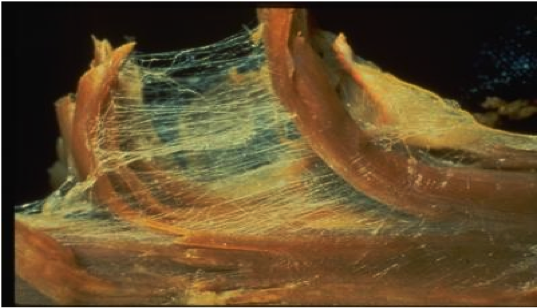A sustained pressure applied on to skin creating mechanical & neurological responses; inducing a pain relieving & ‘freeing’ affect to “dysfunctional” fascia, joints and limbs.
Myofascia is extremely good at responding to physical force and kinetic energy by redistributing load and tension around the body: Biotensegrity (Ingber, 2008). This affords great resilience and adaptability to our muscloskeletal system. However disease, overuse or disuse can lead to compensatory tension remaining for sustained periods of time. This is thought to lead to excessive collagen matrix (‘building block’ of fascia) remodeling leading to thickening, adhesion, scarring and fibrosis of fascia.
Thickening and loss of mobility of lumber fascia has been demonstrated in people with chronic back pain (Langevin et al, 2011); however myofascial tension can occur anywhere in body causing varying degrees of pain and immobility.
Using myofascial release techniques (direct and indirect) the skilled therapist can trigger or stimulate a therapeutic affect to release this tension. Exactly how this occurs is still unknown, but I believe it will always vary according to an individuals’ history, problem & symptoms. When combined with other soft tissue techniques, active release and rehabilitation exercises it can be an effective and powerful treatment.
What myofascial release is NOT:
I’ve known and read many doctors & surgeons deriding the term ‘myofascia release’, arguing that unless you physically cut fascia (or any soft tissue) with a scalpel there is no way you can ‘release’ it using just your hands (a tensile strength of around 900kgs after all). It maybe a semantic argument but every day manual therapists including myself use various forms of ‘release’ technique to effectively to treat chronic pain and dysfunction. And its is not by cutting, tearing or dissecting fascia with our hands (as if!). Its theorised that by applying specific tension with movement through the skin mechanotransduction occurs provoking and immediate and lasting effects in the myofascia, altering the tension across the affected area.

To book a Myofascia Release consultation and treatment in Marlow with Mark please check availability and book online here.
Langevin et al. (2011) Reduced thoracolumbar fascia shear strain in human chronic low back pain. BMC Musculoskeletal Disorders 12:203.
Ingber (2008) Tensegrity-based mechanosensing from macro to micro. Progress in Biophysics and Molecular Biology 97(2-3), pp.163-179

 Enter your name and email and request our free ebook: 7 Habits of Highly Effective Runners
Enter your name and email and request our free ebook: 7 Habits of Highly Effective Runners